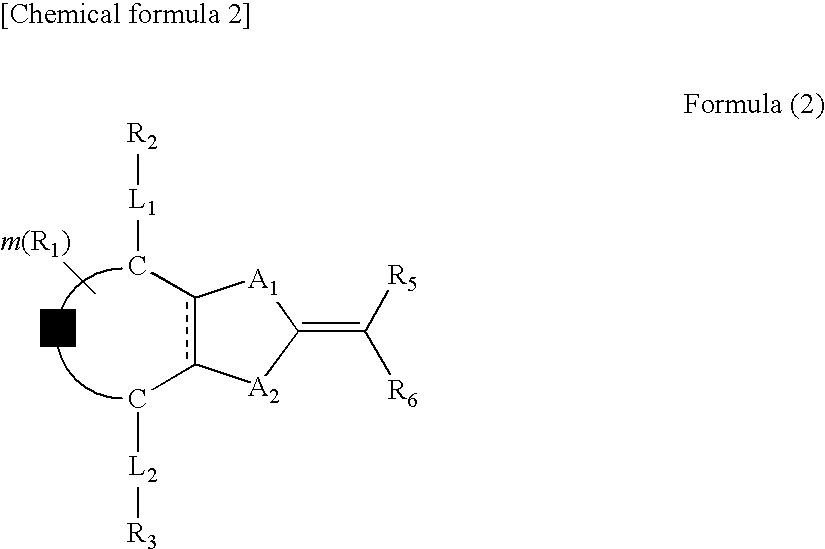Optical film and retardation sheet, and liquid crystal compound
a technology of optical film and retardation sheet, applied in the direction of optical elements, instruments, transportation and packaging, etc., can solve the problems of difficult to solve the above problems, complicated process for controlling optical directions, and difficult to arbitrarily control the wavelength dispersion by the method, etc., to achieve the effect of simple production process
- Summary
- Abstract
- Description
- Claims
- Application Information
AI Technical Summary
Benefits of technology
Problems solved by technology
Method used
Image
Examples
example 1
Preparation of Exemplified Compound (2)
[0267]The Exemplified compound (2) was prepared, in accordance with the following scheme:
[0268]The synthesis of each of Compounds (2-1) to (2-3) was carried out in reference to the methods described in “Journal of Chemical Crystallography” (1997), 27(9), p. 515-526.
[0269]To 50 ml of a tetrahydrofuran solution of 8.5 g (0.1 mol) of cyanoacetic acid (2-4) and 14.4 g (0.1 mol) of 4-hydroxybutyl acrylate (2-5), 20.6 g (0.1 mol) of dicyclohexylcarbodiimide (DCC) was added dropwise under cooling on ice. The resultant mixture was warmed to room temperature and stirred at the same temperature for 2 hours, and the resultant solid matter was removed by filtration. The solvent in the filtrate was removed off by distillation under reduced pressure, and the resultant solid matter was removed by filtration, to give 18.6 g of Compound (2-6) (yield: 88 mol %).
[0270]A suspension of 15.7 g (50 mmol) of Compound (2-3), 12.7 g (60 mmol) of Compound (2-6), and 50 m...
examples 2 and 3
Preparation of Exemplified Compounds (1) and (3)
[0274]Exemplified compounds (1) and (3) were prepared in the same manner as in Example 1, except that 4-hydroxybutyl acrylate used in Example 1 was replaced with 2-hydroxyethyl acrylate or 4-hydroxybutyl methacrylate, respectively.
[0275]1H-NMR (CDCl3, 300 MHz):
[0276]0.75-1.25 (m, 36H), 1.40-1.65 (m, 4H), 1.65-2.00 (m, 12H), 2.10-2.25 (m, 4H), 2.45-2.60 (m, 2H), 4.40-4.55 (m, 4H), 5.92 (d, 1H), 6.20 (dd, 1H), 6.50 (d, 1H), 7.21 (d, 2H)
[0277]Mass (m / z, POSI) 863
[0278]1H-NMR (CDCl3, 300 MHz):
[0279]0.75-1.25 (m, 36H), 1.40-1.65 (m, 4H), 1.65-2.10 (m, 19H), 2.10-2.25 (m, 4H), 2.45-2.60 (m, 2H), 4.40-4.55 (m, 4H), 5.58 (d, 1H), 6.15 (d, 1H), 7.21 (d, 2H)
[0280]Mass (m / z, POSI)=905
example 4
Preparation of Exemplified Compounds (78) to (95)
[0281]Exemplified compounds (78) to (95) were prepared in the same manner as in Example 1. The structure of each of the thus-obtained compounds was identified in the same manner as in Examples 1 to 3, based on various spectroscopic data, such as the data of NMR spectrum and Mass spectrum.
[0282]The phase-transition temperatures of the respective compounds obtained in Examples 1 to 4 are shown in Table 1. In Table 1, “Cr” represents crystalline phase, “Ne” represents nematic phase, “Iso” represents isotropic phase, and “Col” represents columner phase, respectively. Numbers represent the phase transition temperatures in the course of heating.
TABLE 1Exemplified compoundPhase-transition temperature (° C.) (1)Cr 180 Ne 280 Iso (2)Cr 142 Ne 250 Iso(78)Cr 137 Ne 210 Iso(79)Cr 147 Ne 163 Iso(80)Col 102 Ne 135 Iso(81)Cr 119 Ne 153 Iso(82)Ne 114 Iso(83)Ne 124 Iso(84)Cr 170 Ne 200 Iso(85)Cr 108 Ne 143 Iso(86)Cr 107 Ne >180 Iso(87)Cr 170 Ne 206 Is...
PUM
| Property | Measurement | Unit |
|---|---|---|
| crystal composition | aaaaa | aaaaa |
| optically anisotropic | aaaaa | aaaaa |
| transparent | aaaaa | aaaaa |
Abstract
Description
Claims
Application Information
 Login to View More
Login to View More - R&D
- Intellectual Property
- Life Sciences
- Materials
- Tech Scout
- Unparalleled Data Quality
- Higher Quality Content
- 60% Fewer Hallucinations
Browse by: Latest US Patents, China's latest patents, Technical Efficacy Thesaurus, Application Domain, Technology Topic, Popular Technical Reports.
© 2025 PatSnap. All rights reserved.Legal|Privacy policy|Modern Slavery Act Transparency Statement|Sitemap|About US| Contact US: help@patsnap.com



